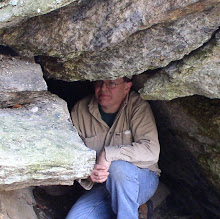Certainly the 'dye-in-the-wool' caver would cringe at yet another classification
of caves. Especially one that couldn't be more 'karst-less' than a pile
of boulders. Yet many of these rock formations provide ample passageways for true
exploration. And since they owe their origin to the randomness of glacial
action, and not the disintegration of cliffs, they cannot come under the heading
of talus caves.
History, itself, records many of these formations as 'caves' and the greater
majority of them lie in the eastern half of the state. In fact a statewide
survey of caves begun over seven years ago, reveals the majority of caves in
eastern Massachusetts are of the glacial boulder variety.
Coming as no surprise, tradition and archeological evidence, link our Native
Americans to many of these natural rock formations. Most famous of these, both
in history and caves, was Wampanoag tribe leader Metacom or King Philip. His
caves stretch across the southeast region of Massachusetts. One in Freetown
consists of a chamber located under a single rock. Farther to the northwest in
Norton is one of his better know sites where it is said he stayed on his fishing
trips to nearby Winnecunnet Pond. Three large blue-gray boulders of the Rhode
Island Formation forms the cave.
Moving farther to the east we find two King Philip sites in close proximity at
Sharon. In each case it is a piling up of rocks forming a crude enclosure and
in each case they bear the name King Philip's Rock. Another more spectacular
formation exists in Uxbridge where it is also know as King Philip's Rock. The
history here is Philip, along with braves, stayed at this site just before
carrying out an attack at a nearby town.
Metacom was not the only Native American to have his cave and the inevitable
Indian caves do exist. Brockton's is comprised of three gigantic erractics piled
upon one another while Plymouth's Cleft Rock provided shelter in a 19-foot
passage within a fractured boulder. Saugus too has its Indian shelter amongst
the rocks that now plays home to an old discarded refrigerator!
Other sites of 'erratic inhabitations' include an early settler of Sturbridge -
later Southbridge - at Deneson Rock, a homeless man named Theodore at Odie's Den
in Cohasset, wolfs at Wolf Rock Den in Carlisle, and the obligatory Bear's Den
with its bear at Essex.
Finally, we may want to ponder the question of how dubious a cave can be and
still be a cave. Cape Ann is perhaps the rockiest region in the state and
boulders piled on - or around - other boulders is not that all uncommon. The
famed Dogtown area has one rock formation where suicidal Abram Wharf crawled in to die after
slitting his throat. Then there is the category of single erratics, so enormous
in nature that they contain their own cavities or passages underneath. Of
notable interest would be Peabody's Ship Rock and House Rock in Weymouth. These
two rank among the largest erratics in the state and contain their own versions of
'pseudo' caves.
This article originally appeared in the Northeastern Caver



